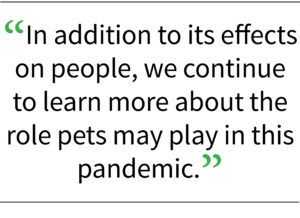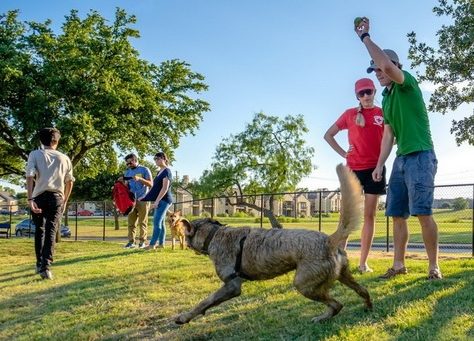Dog parks and day care may be considered a riskier activity.
By Dr. Jeanne Haggerty-Arcay

Jeanne Haggerty-Arcay
We are living through a time that will go down in history . . . the COVID-19 Pandemic of 2020. Health experts have been working tirelessly and have made great progress in collecting data, improving treatments and developing vaccines in record time. Yet despite being nearly a year into the pandemic, there is still so much we do not know about this virus. Large gaps remain in the details of the virus’ transmission and in exactly the virus acts on the body, affecting multiple organ systems and creating prolonged illness, as seen in “long haulers.”
Although the main preventative measures remain relatively constant – wear  a mask and keep your distance – the more refined recommendations have been going through constant evolution as we learn more about this virus. In addition to its effects on people, we continue to learn more about the role pets may play in this pandemic. There have been several cases to date of COVID-19 infections in dogs, cats and large cats. Some of these animals exhibited symptoms while others seemed otherwise healthy but tested positive. This has left many unanswered questions. It remains unclear if animals accumulate sufficient virus in their system to transmit the virus. There has also been changing data in regard to COVID-19 and fomites. Fomites are objects that can become contaminated with an infectious agent (such as a virus) then pass that virus on to someone who touches that contaminated surface.
a mask and keep your distance – the more refined recommendations have been going through constant evolution as we learn more about this virus. In addition to its effects on people, we continue to learn more about the role pets may play in this pandemic. There have been several cases to date of COVID-19 infections in dogs, cats and large cats. Some of these animals exhibited symptoms while others seemed otherwise healthy but tested positive. This has left many unanswered questions. It remains unclear if animals accumulate sufficient virus in their system to transmit the virus. There has also been changing data in regard to COVID-19 and fomites. Fomites are objects that can become contaminated with an infectious agent (such as a virus) then pass that virus on to someone who touches that contaminated surface.
 It has been unclear how long COVID-19 can survive on various surfaces, such as glass, doorknobs, counter tops and take-out food containers. Pets, their hair and their accessories (leashes, collars, etc.) are also thought to act as fomites but it is unclear how long the virus can live on the fur of a dog or if it can survive in sufficient amounts to infect another person. Given the great many unknowns of this virus, there are some general recommendations you should follow with your pet.
It has been unclear how long COVID-19 can survive on various surfaces, such as glass, doorknobs, counter tops and take-out food containers. Pets, their hair and their accessories (leashes, collars, etc.) are also thought to act as fomites but it is unclear how long the virus can live on the fur of a dog or if it can survive in sufficient amounts to infect another person. Given the great many unknowns of this virus, there are some general recommendations you should follow with your pet.
- Keep Your Distance. Keep yourself and your pet confined to your social bubble whenever possible and maintain social distancing when walking. Dog parks and day care may be considered a riskier activity.
- Isolate if Sick. If you have COVID, isolate yourself from your pet if possible. If you cannot have someone else care for your pet, wear a mask and minimize your contact.
- Bathing. We believe that simple bathing with soap and water would be effective at removing contamination from a pet’s coat if you suspect contamination or if you are caring for a pet for someone who has been sick. Avoid using harsh disinfectants directly on your pet.
- Travel Safely. Despite CDC warnings, we know that many people will still choose to travel or may have to travel out of necessity. Consider leaving your pet at home and have a pet sitter come to feed. Traveling with your pet just increases your travel risk by an unknown degree since we do not know a pet’s capacity for transmitting COVID. Testing is not currently widely available for pets. There is so much that we still need to learn about how our furry friends fit into the whole COVID equation. Use common sense, minimize contact, avoid crowds, avoid travel and practice good basic hygiene. We are truly in unchartered territory. But as long as everyone does their part, follows the science and lends each other a helping hand we will get through this together.








